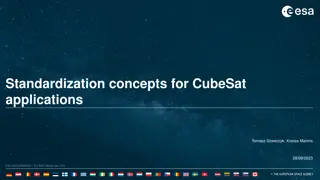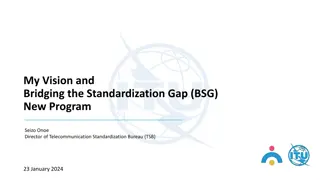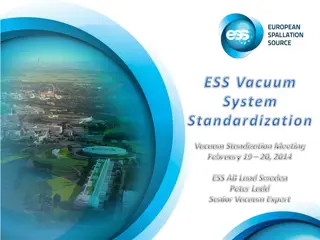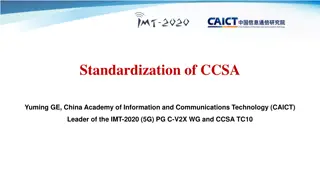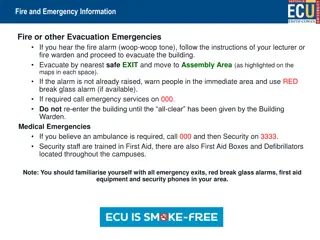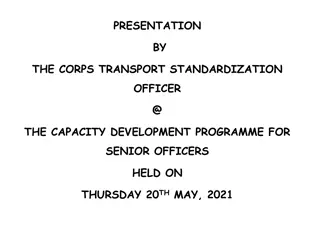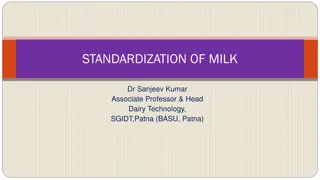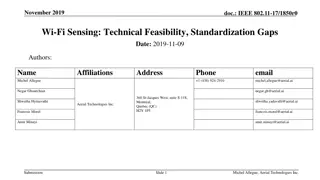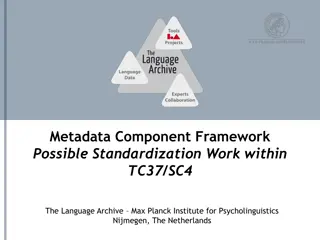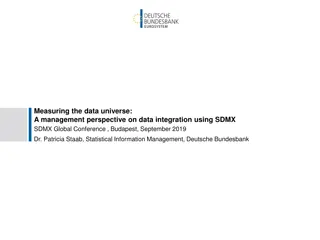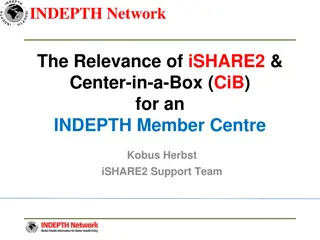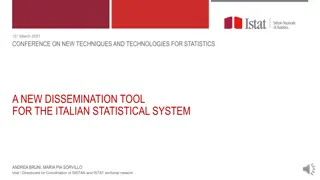
Standardization of ECU Data and OBD Systems Overview
Learn about the standardization of ECU data and On-Board Diagnostic (OBD) systems, their history, the importance of OBD systems in minimizing emissions, required standardized data for HD OBD, and details on standards like SAE J1939 and SAE J1979. Discover how OBD systems help monitor emissions, alert drivers to malfunctions, and aid repair technicians in effective diagnosis and repair strategies. Stay informed about the evolution of OBD systems in light-and medium-duty vehicles and heavy-duty engines.
Uploaded on | 13 Views
Download Presentation

Please find below an Image/Link to download the presentation.
The content on the website is provided AS IS for your information and personal use only. It may not be sold, licensed, or shared on other websites without obtaining consent from the author. If you encounter any issues during the download, it is possible that the publisher has removed the file from their server.
You are allowed to download the files provided on this website for personal or commercial use, subject to the condition that they are used lawfully. All files are the property of their respective owners.
The content on the website is provided AS IS for your information and personal use only. It may not be sold, licensed, or shared on other websites without obtaining consent from the author.
E N D
Presentation Transcript
STANDARDIZATION OF ECU DATA George Gatt In-Use Retrofit Section / Heavy-Duty In-Use Strategies Branch California Air Resources Board PEMS CONFERENCE WORKSHOP APRIL 11, 2013 CE-CERT / UCR
Background What are On-Board Diagnostic (OBD) Systems? Self-diagnostic systems incorporated into the engine ECU Monitors virtually every component that can increase emissions Alert the driver (MIL) Provide information (data, DTCs) to assist repair technicians Why OBD Systems? Minimize in-use emissions by: Identifying vehicles with emission-related malfunctions Alerting operator to enable timely repair Assisting repair technicians for effective diagnosis and repair Encouraging durable emission controls
History of OBD Light- and Medium-Duty Vehicles (<14,000 lbs) 1988: OBD I- minimal monitoring, no standardization 1996: OBD II- comprehensive monitoring, standardized information for scan tools Ongoing updates every ~2 years Heavy-Duty Engines 2010: HD OBD-initial phase-in, one engine model per manufacturer, no standardization 2013: HD OBD-required on all on-road engines, standardized information for scan tools Ongoing updates every ~2 years
Required Standardized Data HD OBD is only CARB regulation that requires standardized data Used to ensure easy access to data necessary for emission repairs Also used to facilitate inspection or compliance testing Vehicles/engines can be recalled for not complying NTE and PEMS testing regulations do not require standardization of engine data needed for testing Absent OBD requirements, manufacturers not required to adhere to any SAE standard or report any specific data
Standardization Details Two standards to choose from for HD OBD: SAE J1939 Defines connector, protocol, and messages Baud rate: 500k required for 2016+MY, 250k or 500k allowed for 2013-2015MY Used mostly by Cummins, DDC, Navistar, and Paccar SAE J1979 & ISO 15765-4 Identical to connector, protocol, and messages used by light-duty vehicles since 2008 MY Used mostly by GM, Ford, Hino, Volvo, Isuzu
Examples of Standardized Data HD OBD regulation defines specific parameters that must be reported Only requires a subset of the parameters defined in J1939 Defined in J1939 does not mean required by HD OBD Data for emission-related troubleshooting and repair E.g. engine speed, coolant temperature, exhaust temperature sensor readings, NOx sensor readings, fault codes, etc. Data for facilitating inspections E.g., MIL command status, chassis VIN, etc. Data for facilitating compliance testing E.g., frequency of operation of individual diagnostics, frequency of operation of some AECDs, etc. Including data about NTE operation and data intended to make PEMS testing easier Back-up slides at end of presentation provide a list of required parameters
NTE Status for NOx and PM NOx NTE Control Area Status Parameter NTE ZONE Reports engine is currently: inside NTE control area, or outside NTE control area, or in a manufacturer-specific carve-out area, or in a NTE deficiency area Can be used to confirm instantaneous data points are in the NTE region Analogous parameter exists for PM
Torque Data Consistency of Torque Implementation? Torque Accuracy?
Torque Data Issues Goal: All manufacturers report torque consistently so values can be relied upon for PEMS testing Issue: As currently implemented, same torque parameter represents different values for different manufacturers Example: SPN 514 nominal friction torque generally includes torque to run base engine accessories (oil pump, internal engine friction, etc.) but sometimes includes non-base engine accessories (cooling fan, etc.)
Resolving Torque Data Issues Plan: Working with SAE to revise definitions to ensure consistent implementation Delineate what frictions must be included and excluded Appears that PEMS needs something that matches Brake Power definition1 in 40 CFR 1065.1001 But, could use some help from knowledgeable PEMS equipment manufacturers or others on this effort Per HD OBD regulation, reported torque must be most accurate values calculated within the ECU Cannot report a less accurate value over standardized data than available on proprietary data 1CFR 40 1065.1001 defines Brake Power as: The usable power output of the engine, not including power required to fuel, lubricate, or heat the engine, circulate coolant to the engine, or to operate after-treatment devices. If the engine does not power these accessories during a test, subtract the work required to perform these functions from the total work used in brake-specific emission calculations. Subtract engine fan work from total work only for air-cooled engines.
Additional Relevant Data For 2016+ MY engines, engines must report: Fuel Rate (mg/stroke) Modeled Exhaust Flow (mass/time) Data can be helpful for PEMS testing Time-aligning ECU data and other sampled data Potential Method 3 usage
Summary With implementation of HD OBD, manufacturers now required to adhere to standards and report specific data First steps taken to standardize data needed for PEMS testing Further refinement (especially for torque) still needed
Back-Up Slides: OBD Required Data Calculated Load Driver s Demand Engine Torque Actual Engine Torque Reference Engine Maximum Torque Engine Coolant Temperature Engine Oil Temperature* Engine Speed Time Elapsed since Engine Start Fuel Level* Vehicle Speed* Barometric Pressure ECU Voltage Number of Fault Codes Monitor Readiness Status Distance Traveled since Fault Codes Cleared Number of Warm-ups since Fault Codes Cleared MIL status NOx NTE control area status PM NTE control area status * If used as part of the OBD system on the engine
Back-Up Slides: OBD Required Data PM filter inlet temperature** PM filter inlet pressure** PM filter outlet pressure** PM filter outlet temperature** PM filter delta pressure** Exhaust gas temp sensor** Turbo speed** VGT position** VGT commanded position Turbo compressor inlet temperature** Turbo compressor inlet pressure** Turbo turbine inlet temperature** Turbo turbine outlet temperature** EGR Temperature** Reductant (Urea) Tank Level* NOx sensor output** PM sensor output** Distance traveled while SCR inducement active * If used as part of OBD system ** If engine is actually equipped with this sensor
Back-Up Slides: OBD Required Data Engine Intercooler Temperature** Boost Pressure** Mass Air Flow** Ambient air temperature** Commanded EGR valve position Actual EGR valve position** EGR error between actual and commanded** Fuel rate Turbo intake air temperature** Normalized trigger for PM filter regeneration (e.g., how close is it to triggering an active regen) PM filter regeneration status (e.g., is it in an active regen) Average distance between PM filter regenerations Accelerator Pedal Position Fuel Rail Pressure** Commanded Fuel Rail Pressure Fuel Injection Timing Intake air Temperature** ** If engine is actually equipped with this sensor



